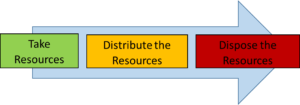Regenerative Economy
-
Module 01: Introduction1.1 Lesson-1: Interested in Regeneration?
-
1.2 Lesson-2: What is Regenerative Economy?
-
1.3 Lesson-3: Principles of Regenerative Economy9 Topics
-
1.3.1 Principle 1: Maintain strong, cross-scale circulation of key flows, such as energy, information, resources, and money.
-
1.3.2 Principle 2: Regenerative and sustained re-investment
-
1.3.3 Principles 3 & 4: Maintain Trustworthy Inputs and Healthy Outputs
-
1.3.4 Principle 5: Maintain a good balance between different types of organizations.
-
1.3.5 Principle 6: Maintain a balanced mix of resiliency and effectiveness.
-
1.3.6 Principle 7: Maintain sufficient diversity
-
1.3.7 Principle 8: Encourage cooperative relationships and principles that are shared by all
-
1.3.8 Principle 9: Encourage positive action and restrict speculative and overly extroverted behavior
-
Principle 10: Encourage efficient, flexible, group learning
-
1.3.1 Principle 1: Maintain strong, cross-scale circulation of key flows, such as energy, information, resources, and money.
-
1.4 Lesson-4: Towards Regenerative Economy1 Quiz
-
Module-02: Go Beyond the Circles2.1 Lesson-1: From Linear to Circular Economy
-
2.2 Lesson-2: The Nested System
-
2.3 Lesson-3: From Focusing on the Product to Focusing on the Process1 Quiz
-
Module-03: Regenerative Economy Mindset Shifting3.1 Lesson-1: Shift Mindset to Transform the System1 Topic
-
3.2 Lesson-2: Shift Mindset: “Doing” to “Being”2 Topics
-
3.3 Lesson-3: Shift Mindset: “Ego” to “Soul”1 Topic|1 Quiz
-
Module 04: Regenerative Economy Framework4.1 Lesson-1: Levels of Paradigm6 Topics
-
4.2 Lesson-2: Understanding Levels of Paradigm as a System
-
4.3 Lesson-3: Evolving a Practice of Regenerative Economics5 Topics
-
4.4 Lesson-4: Quantitative Growth to Qualitative Growth2 Topics|1 Quiz
-
Module 05: Collaborative Approach to Regenerative Economy5.1 Lesson-1: Ecology and Regenerative Economy 1
-
5.2 Lesson-2: Economy of Human Development9 Topics
-
5.3 Lesson-3: Regenerative Approach to Whole Economic Development7 Topics
-
5.3.1 Risks Associated with Traditional Economic Growth
-
5.3.2 A Regenerative Evolutionary Strategy to Creating Community Wealth
-
5.3.3 Developing Place-Sourced Community Intelligence: A Three-Phase Strategy
-
5.3.4 Phase One: Thinking Strategically
-
5.3.5 Phase Two: Changing Systems
-
5.3.6 Phase Three: Institutionalizing Strategic Planning Patterns and Fields
-
5.3.7 The Changes
-
5.3.1 Risks Associated with Traditional Economic Growth
-
5.4 Lesson-4: Regenerative Culture3 Topics|1 Quiz
-
Module 06: Regenerative Investment6.1 Lesson-1: The Role of Businesses2 Topics
-
6.2 Lesson-2: Investing from a Regenerative Mind1 Topic
-
6.3 Lesson-3: Food System Investing in a Regenerative Economy4 Topics|1 Quiz
-
Conclusion
Participants 5727
2.1 Lesson-1: From Linear to Circular Economy
April 2, 2023
A common paradigm for integrating operations into business to generate things sustainably is the circular economy. The three guiding concepts of this paradigm are to 1) prevent waste and pollution through design, 2) reuse products and materials, and 3) regenerate ecosystems.
The linear approach to manufacturing and consumption, which not only harms the natural systems of our world but also cannot be sustained, is opposed by the circular economy model. We are aware that the resource we can use to produce the goods needed to preserve the living standards of humanity are finite. Here is the linear approach-
This method offers a remedy for the detrimental consequences that traditional linear production-and-consumption processes—namely, the extraction of raw materials to produce and distribute goods for human consumption—have on natural systems. It refocuses producers’ attention on creating procedures and business plans that reduce or do away with waste.
Kate Raworth offers a separate idea, the Doughnut Economic Model, as just a means to consider sustainable economies in the twenty – first century, in an analogous effort to progress towards a new economy. Two circles make up the doughnut. Twelve basic human needs—including access to food, justice, water , and education—are represented by the inner ring, which also serves as the social basis. Nine planetary boundaries, or a sort of ecological ceiling, are shown in the outer ring. The equilibrium is upset and an unsustainable condition results when human productive or pleasure-seeking actions cross those lines. Raworth refers to this area as “a safe and just home for humanity” between these two rings. According to her, this is the perfect location for our economies.
Producing products through a cyclic process:
The Circular Economy Model calls on us to abandon our widely accepted way of life and the production-consumption paradigm in order to immediately cease the harm that comes from our extraction, manufacture, distribution, acquisition, and discarding of materials. It challenges us to start exhibiting environmental concern.
Similar to this, the Doughnut Economic Model encourages us to become more conscious of the social and environmental limitations that our existing production and consumption culture is breaching in order to reach an equilibrium and create “a secure and just home for humanity. Compared to the current, widely supported economy, these measures represent a significant advancement. These suggestions appear to come from an axiom that highlights the significance of stopping the harm produced by human activities when they are closely examined. In light of the Dimensions of Paradigm framework put forth by Sanford and Haggard, it can be seen that their foundation is a paradigm for stopping chaos.
These circular strategies seek to shift the focus of manufacturers and distributors of commodities from contributing to the issue to minimizing or even eliminating its negative impacts. They want human actions to stay within the parameters of social and ecological bounds so that we don’t endanger ourselves or the environment. By utilizing these models, we are attempting to address the issues facing our society from a viewpoint that prioritizes stopping harm. These models are far far from advocating for a sustainable economy.
We are seeking to protect and enhance natural resources if we base our change initiatives on this. At first glance, this appears to be interesting! To stop producing waste would be a wonderful thing. Even better would be for our production-consumption activities to go up the value chain. It sounds like a great idea to learn how to work in a way that maintains and restores natural systems by “upcycling,” which means that conditions are established for their improvement throughout their life cycles.



